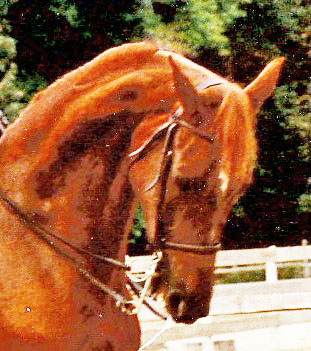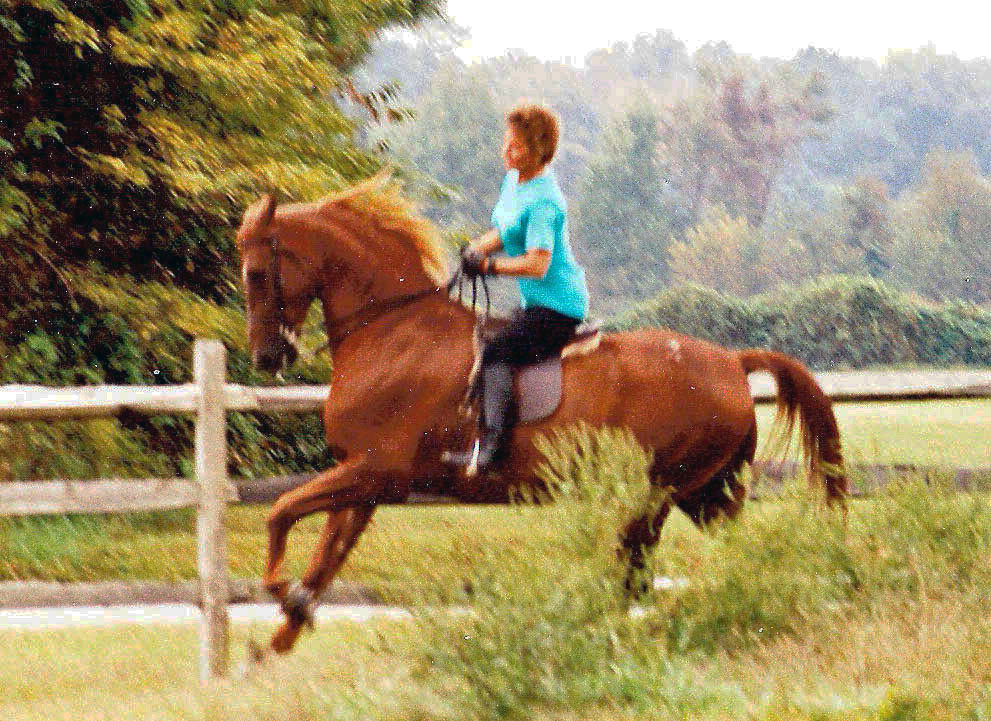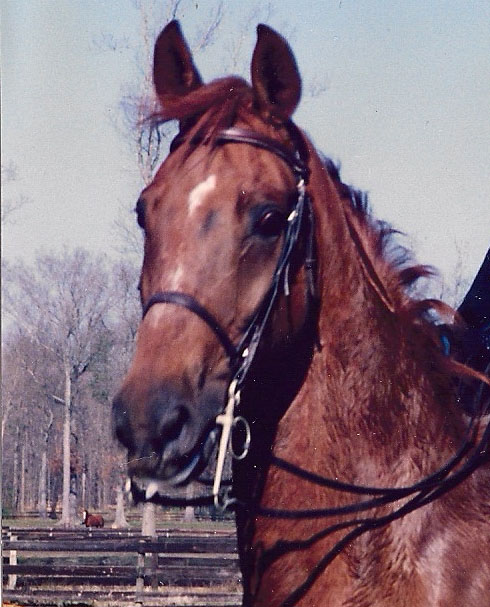
Casey
|
| ANOTHER LEGACY ANIMAL THERAPY
FOR GRIEVING CHILDREN |

Franne
riding Casey |

Casey
|
My Beloved Casey, 29
Faithful Companion For 22 Years
In Memoriam
December 9, 2010
In 1988, I
was lecturing at a hospital, discussing suicide and how the grief
from this manner of death is the most complicated in the hierarchy of
grief. I noticed a woman jump out of her chair and leave the room. I
finished my lecture and walked out of the lecture hall, where I found
this same woman waiting for me. She apologized for leaving the lecture,
which I assured her was perfectly all right, and told me that one month
before, her 30 year old daughter had killed herself and her nine year
old granddaughter, Emma, had inadvertently seen her mother's suicide.
Emma's mother, who suffered from mental
illness, had gone into the
bathroom with a butcher knife, climbed into the bathtub and cut her own
throat. Her husband entered the bathroom just as she was doing this and
pulled her out of the bathtub. He was so frantic to get his wife out of
the tub, he didn't notice that she was still holding the butcher knife.
As he was pulling her out of the tub, she plunged the knife into the
wound in her neck. In his haste to save his wife, Emma's father left
the bathroom door open and tragically, Emma saw her mother stab herself
in the neck. She was so traumatized, she stopped talking. And had not
spoken one word for a month.
Her
grandmother asked me
if I could possibly work with Emma, who
was temporarily staying with her. I agreed to come to the
home to meet Emma and try to get to know her a bit. I made two
visits, making certain that I never asked her anything she couldn't
answer by either shaking her head or nodding. I did not bring up the
subject of her mother.
During
the second visit,
I asked Emma if she liked animals and
she nodded "yes". I asked her if she like horses and she, again, nodded
her head. I told her I had a horse named Casey, who had been
whipped
and
beaten and that I had given him a good home and that I loved him a lot.
I
asked her if she would like to have her grandmother bring her to meet
Casey and she nodded.
The
following week, the
grandmother brought Emma to my house
to meet Casey. He is a very big horse and can be a little
intimidating because of his size, so I told Emma that I would brush him
while she watched from some distance. I glanced at her frequently
to make sure she wasn't frightened and before she and her grandmother
left that day, I had put a mounting block beside Casey for her to stand
on and I stayed close to her as she tentatively brushed his mane.
They
came back the
following week and I showed her how to
groom Casey's legs and sides, which she could barely reach. I also
showed her how to hold a carrot, making her hand flat like a table so
he wouldn't mix up fingers and carrots and with a little help from
me, she gave him the carrot.
We
spent some time
talking - me talking, Emma nodding - about
how scared Casey had been when I first brought him home, because people
had been so mean to him and I asked her if she thought it would have
made him very sad when people hurt him. She nodded solemnly, so I
gently commented that she must be very sad because her mother died and
must have been very frightened by what she saw.
That
was my very first
mention of her mother. And I said it
while she was brushing one of Casey's legs and I was brushing his tail.
I just casually slipped it into the conversation, intentionally
couching it as a comment rather than a question, and continued brushing
Casey's tail. I didn't make eye contact with her because I didn't want
her to feel I was putting her on the spot. I also wanted to begin
conveying to her that it was perfectly all right to be scared and sad
about what happened to her mother, just as Casey had been scared and
sad about what happened to him. I also felt it was important not to
make any discussion about her mother be the primary focus, but to make
it less threatening by addressing it only as an adjunct to our
interactions with Casey. That was the only discussion we had about her
mother that day. Before she left, I asked her if she would like to sit
on Casey's back the next time she visited and she nodded that she
would.
The
next week, I rode
Casey for about half an hour before
their arrival so he would be less energetic, then put Emma on his back
in the saddle, and led her around for about fifteen minutes. After we
unsaddled Casey and were grooming him, I asked Emma if she had enjoyed
her ride. She nodded and I saw a fleeting flicker of a smile for the
very first time. I didn't mention her mother this time because I didn't
want her to fear that I was going to try to get her to talk about her
mother - or anything else - every time she came to see Casey.
The
following week, I put
Emma on the saddle in front of me
and we went for a ride. While we were riding, I asked if her
mother had liked animals and she nodded yes. I then asked her if she
thought her mom would have liked Casey and she, again, nodded yes. I
dropped the subject because I was careful to touch on this only
lightly and not exceed her comfort level, so she could begin to trust
me.
When
it came time for
Emma to leave, I asked Emma if she would
like to say goodbye to Casey by herself and she nodded. He was in
cross-ties so he wouldn't be wandering off, and I made sure she
remembered not to walk behind him, and how to safely give him a carrot.
I walked around a nearby corner and stood there. I heard crunching, so
I knew she had given Casey his carrot, and then, to my absolute
amazement and joy, I heard Emma softly say "I love you,
Casey".
I
was
in tears and felt like doing cartwheels, but I didn't want to alarm
her, so I waited a few moments, then quietly came back around the
corner and
asked her if she thought Casey was happy to hear her tell him that she
loved him. She started to nod, then very softly said "yes". I simply
said "me, too", gave her a hug and walked with her out of the barn to
where her grandmother was coming to pick her up. I didn't tell the
grandmother that Emma had spoken aloud a little, because I didn't want
there to be any pressure on Emma to keep talking that day, but I did
tell her that when she felt like it, she could tell her grandmother
what happened today that made Casey really happy. She did tell her a
few hours later and her grandmother was even more joyous than I had
been. She put Emma into specialized counseling and she and Emma would
come out to see Casey every once in awhile, until I moved back to
Vermont.
And
that is how
Casey, my beloved first rescue animal, whose registered name was
Another Legacy when I found him, was responsible for the launching of
the free Another Legacy Animal
Therapy For Grieving Children.
Several
animals have
since joined the program. In addition to
Casey, my menagerie of dear animal companions now consists of four
miniature horses, one sheep, two pygmy goats and two llamas. My
sheep and Casey
are rescue animals and the llamas, goats and one of the miniature
horses were donated to the program.
The
smaller
animals - miniature horses and
goats - are diminutive little critters who, because of their size, feel
warm and safe to children. In fact, three of the horses are so small,
they can stand under Casey's belly and not touch it. I transport
everyone, except Casey, in my van and they have been in elementary and
grade schools, nursing homes, hospital emergency departments, funeral
homes and
private residences.
Another Legacy's focus
is on children whose
loved ones have died suddenly, whether naturally, accidentally or from
homicide or suicide. The grief from sudden death is completely
different from expected death, when families have time to prepare and
say goodbye. Therefore the emotional needs for those left behind
because of sudden death are much greater and more complicated. Ordinarily,
childrens' imprinted memories of
sudden death may be focused on a household full of weeping relatives
and friends and a parade of adult strangers - funeral directors, police
officers and people dropping off meals, doing errands, yardwork or
housework. Crowds of unfamiliar adults in the home under these
circumstances can be quite frightening to children and there often
isn't anyone their own size to talk to or spend time with.
If
grieving
children don't have a chance to
talk about their death losses and to say goodbye to those who died, the
experience, which I call Negative
Death Imprinting™, can affect
them for years. They may need therapy as adults because of unresolved
grief issues or grow up with a pervasive fear of death or of dead
bodies.
There's
a huge need for
people who can provide Positive
Death Imprinting™
for children.
And with these animals, I try to
give grieving children a positive legacy for their future, with a small
memory of joy or laughter at the worst time of their life.
|
